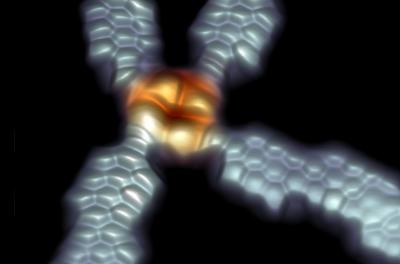A collaboration between Spanish research institutesâled by the nanoGUNE Cooperative Research Center (CIC)âhas achieved a breakthrough in so-called molecular electronics by devising a way to connect magnetic porphyrin molecules to graphene nanoribbons. These connections may be an example of how graphene could enable the potential of molecular electronics.

Porphyrin is an important molecule that is responsible for making photosynthesis possible in plants and transporting oxygen in the blood. Recently, researchers have been experimenting with "magnetic porphyrins" and discovered that they can form the basis of spintronic devices. Spintronics involves manipulating the spin of electrons and it is this spin that is responsible for magnetism: When a majority of electrons in a material have their spins pointing in the same direction, the material is magnetized. If you can move all the spins up or down and can read that direction, you can create the foundation of the 0 and 1 of digital logic.
The Spanish researchers have created direct connections to the molecules with atomically precise graphene wires, which covalently bond to specific sites of the molecules. This allows the injection of electronic currents into the molecule, says the team. We further show that even after the connection, the molecule maintains its magnetic property.
The researchers add that they have demonstrated that small variations in the way the graphene nanoribbons are attached to a molecule can alter its magnetic properties. Further, a molecule’s spin can be manipulated via the injected currents. We tested the magnetization by performing tunneling spectroscopy, says the team. We saw that the iron ion maintained its spin and its preferred direction after connection to the graphene nanoribbons, but in a few cases where the bonding was different it completely vanished. So the way of contacting is crucial.
The team sees this work as bringing spintronics into molecular electronics, and has unofficially dubbed it Molecular Spintronics.
In future research, the researchers will aim to use single-molecule magnets, and improve the magnetic function in transport experiments by injecting current though the ribbons. This will be closer to the real usage of these devices.
This work was conducted by teams at CIC nanoGUNE, Donostia International Physics Center (DIPC) and Materials Physics Center (CFM, CSIC-UPV/EHU) and synthetic chemists from CiQUS (Center for Research on Biological Chemistry and Molecular Materials at the University of Santiago de Compostela).

